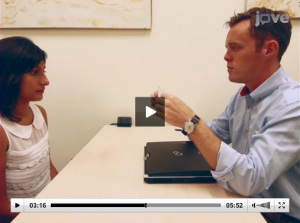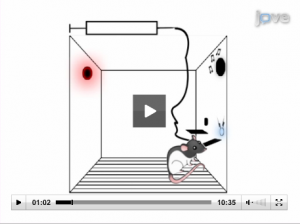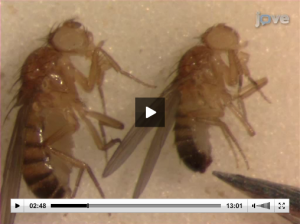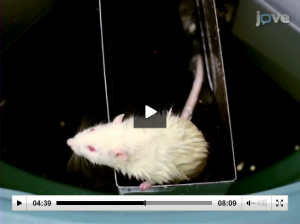This week we feature four Editor’s Picks videos chosen by Allison Diamond, an associate editor for the JoVE Behavior section. Before working at JoVE, Diamond worked in a neuroscience lab at Harvard Medical School.

Ms. Diamond: I think that it’s difficult for people to understand how we can use a fly to study behavior. We sometimes think of consciousness, memory and emotions as mainly human-like qualities, but these videos are amazing—they show us how we can use animals to study these concepts and learn so much more about the human mind and the brain.

Pick 1 — “Handwriting Analysis Indicates Spontaneous Dyskinesias in Neuroleptic Naïve Adolescents at High Risk for Psychosis”
Ms. Diamond: This is a really simple technique. The video highlights how Dr. Vijay Mittal and his lab members use a handwriting analysis software to look at subjects at risk for psychosis. The software indicates dyskinesia—seen as [involuntary] movement in the handwriting. The researchers find that there is greater dyskinesia in the at-risk [for psychosis] group when compared to controls. …It’s incredible to see this done with such a simple approach.

Ms. Diamond: There are a few reasons I love this article, which is about examining drug seeking behaviors in food-restricted rats after training them to self-administer heroin. The first is that there is a huge surgical component in this method. …There are so many little tips and tricks about how to hold the forceps and how to position the animal that you would not [pick up on] from a text manuscript. Additionally, seeing the mice behave is incredible. It’s one thing to read, “The mice press the lever continuously for the drug;” it’s another to see it being done, and to see how training can greatly affect mouse behavior.

Pick 3 — A Single-fly Assay for Foraging Behavior in Drosophila
Ms. Diamond: I always wondered how people used Drosophila for behavioral work. I used to work in a drosophila genetics lab, and I remember talking about fly behavior and always wondered how people studied it, since flies are so tiny. Then I was able work with this author, Dr. Jian Wang, on publishing this technique [with JoVE], which measures the affect of hunger on search behavior. It was very exciting to speak with him and to learn about how the lab members use a computer program to assess fly movements in a light box with a food odor at the center, after a starvation period.

Pick 4 — Use of an Eight-arm Radial Water Maze to Assess Working and Reference Memory Following Neonatal Brain Injury
Ms. Diamond: There are a lot of mazes that are used to look at animal behavior, but this one is specially designed to evaluate working and reference memory performance in mice with neonatal brain injuries, I love this video because it’s amazing to see how mice actually move when you’re testing their behavior. In the past, we were only able to read the patterns of their movements, but being able to see how a mouse actually reacts is very exiting when you’re assessing that very function.
Please share your feedback in a comment below! Love Editor’s Picks? Check out our next collection on 1/13/14 — available on our main page here and on the JoVE blog.


